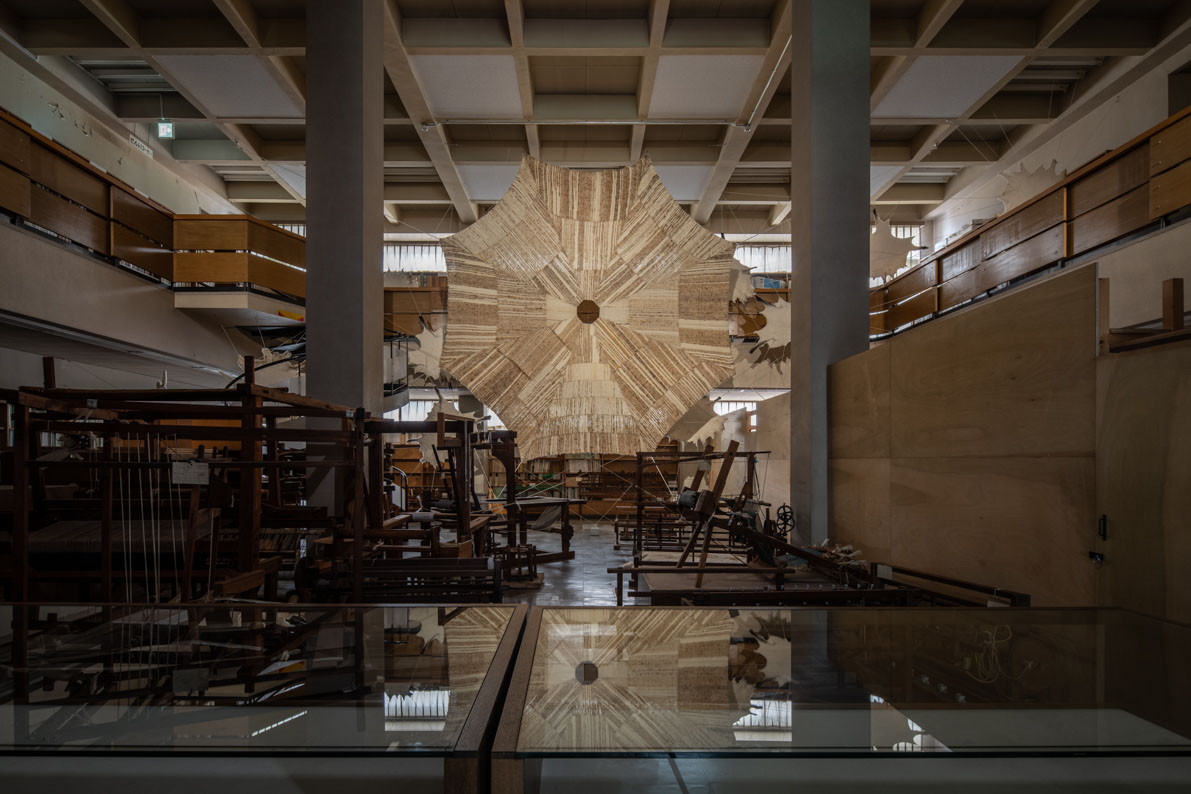ARTISTS
Endo Kaori
- Born 1989 in Osaka, Japan.
- Based in Osaka and Okinawa, Japan.
IC16
Ichinomiya has been a textile town since ancient times, and is especially notable for its status as Japanʼs largest producer of woolen fabrics. That history is embodied in the many looms and everyday household items used by its citizens down the centuries and now housed in the Ichinomiya City Toyoshima Memorial Museum.
When it came to making and presenting her work in Ichinomiya, Endo Kaori noted that the character bi (美) meaning beauty is made up of the characters for large (大) and sheep (羊), suggesting that “sheep” are a latent presence in the practice of art (bijutsu 美術). She then examined the history of people and sheep from Mesopotamian civilization to Christian culture, then through the industrial revolution to the modernization of Japan, dismembered a sheepʼs carcass with her own hands, tanned its skin, and spun and wove its wool into an epic work of ovine art.
In the hall on the second floor hangs a woolen parachute woven by the artist. Sheepʼs wool has long been used to enfold and protect the human body, whether as clothing, or tent-style housing. On the other hand this has led to conflict around sheep as property, and robust woolen textiles have also been made into soldierʼs uniforms in both East and West. It is worth recalling too that while sheep are subject to our care and protection, we humans also have a long history of selectively breeding them as livestock for profit. Endo chose to form this wool with its complex layers of history into a parachute because a parachute is both military materiel, and lifesaving equipment, and both floats in the air, and falls to earth.
Endo also hangs parachute and sheepskin etc. in the air in an attempt to depict a starry sky. Behind this idea are the Bible passage in which a star heralds the birth of Jesus, also known as “the lamb of God,” and the fact that women who work at Ichinomiyaʼs textile mills were once known as “Orihime” or “Weaver Girls,” this also being the Japanese name for the star Vega. Sheep-shaped history and culture, textiles, stars: in the hands of Endo Kaori they transcend time and space, twisting and weaving together, with all their contradictions.
After graduating from the Okinawa Prefectural University of Arts in 2013, majoring in fabric dyeing, in 2016 Endo studied at the Ars Shimura school run by Shimura Fukumi, who has been awarded Living National Treasure status for her tsumugi (pongee) weaving. As she travels around, Endo unravels the crafts, history, everyday lifestyles, and political relations rooted in each location, using her body in activities that expand the potential of the applied arts. Recent exhibitions include Portraits of Ryukyu at the Okinawa Prefectural Museum and Art Museum (2021–22), Welcome, Stranger, to this Place at the Chinretsukan Gallery of the University Art Museum, Tokyo University of the Arts (2021), and the 13th shiseido art egg at Shiseido Gallery, Tokyo (2019).
- Selected Works & Awards
-
- 2021-2022
- Portraits of Ryukyu; Turnover from the models to artists., Okinawa Prefectural Museum and Art Museum, Japan
- 2021
- Welcome, Stranger, to this Place, The University Art Museum, Tokyo University of the Arts, Japan
- 2020
- The Beginning of Life/Art: Cloth Weaves Our Times, from Aomori, Aomori Contemporary Art Center, Japan
- 2019
- The 13th shiseido art egg, Shiseido Gallery, Tokyo, Japan, Art Egg Prize
Exhibition
sheep and sleep, 2021-2022
IC16

- Installation view at Aichi Triennale 2022
- sheep and sleep, 2021-2022
- Photo: ToLoLo studio
- Open
- 10:00-18:00
*Last admission 15 min before closing time
- Closed
- Mondays (except for public holidays)
- Venue / Access
- Toyoshima Memorial Museum
- 11 minutes on foot from Owari-Ichinomiya Station on the JR Tokaido Line.
- 11 minutes on foot from Meitetsu Ichinomiya Station on the Meitetsu Nagoya Line.


![STILL ALIVE Aichi Triennale 2022, July 30 (Saturday) to October 10 (Monday, public holiday), 2022 [73 days]](/2022/en/img/title-logo-date-en.svg)
